Introduction
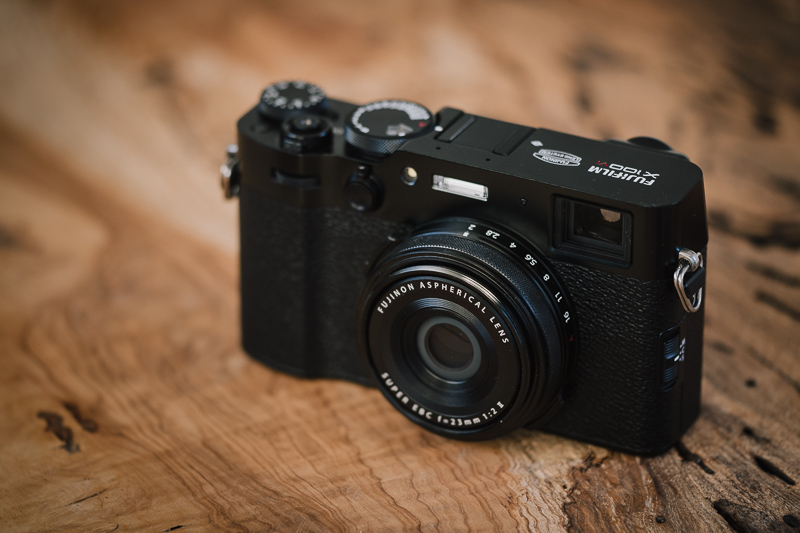
The original Fujifilm X100 hit the market in 2010 and it was an instant success for Fuji. It laid the groundwork for Fuji’s complete APS-C “X” camera system and it remains so popular that they keep updating it every few years, so in 2024 already this 6th generation had been released. Thanks to an internet hype this camera series became so popular, that at some point the prices of used ones were higher than their original prices. Is all that hype justified? Time to find out.
Sample Pictures



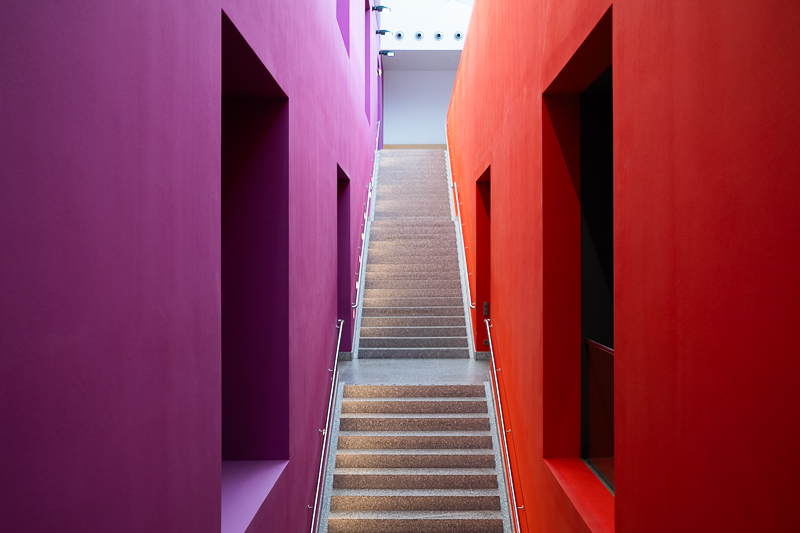
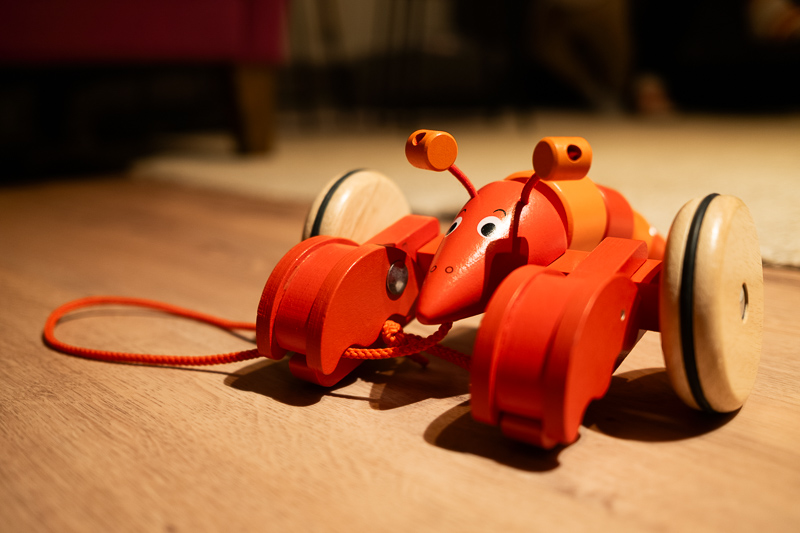
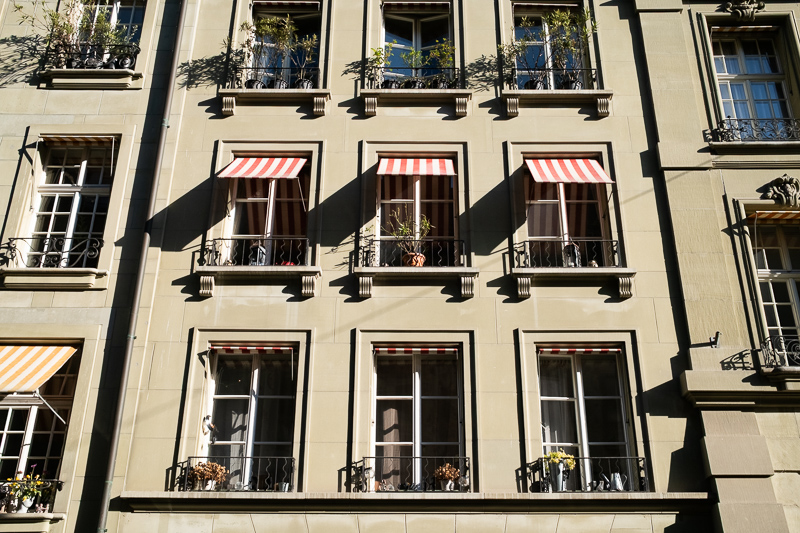
Contents
Specifications
The Fujifilm X100VI has the following specifications:
- Sensor: 40mp APS-C X-Trans
- Lens: Fujinon 23mm 2.0 II (fullframe equivalent: 35mm 3.0)
- Weight: 519g (without hood and caps including battery)
- Filter Diameter: 49 mm (reversed)
- Number of Aperture Blades: 9 (rounded)
- Elements/Groups: 8/6
- Close Focusing Distance: 0.1 m
- Maximum Magnification: 1:5.1
buy from amazon.com | amazon.de | ebay.com | ebay.de | B&H (affiliate links) for $1599
Disclosure
The Fuji X100VI was kindly provided free of charge by our long term reader Florian for review purposes for two months, thanks a lot!
Handling / Build Quality
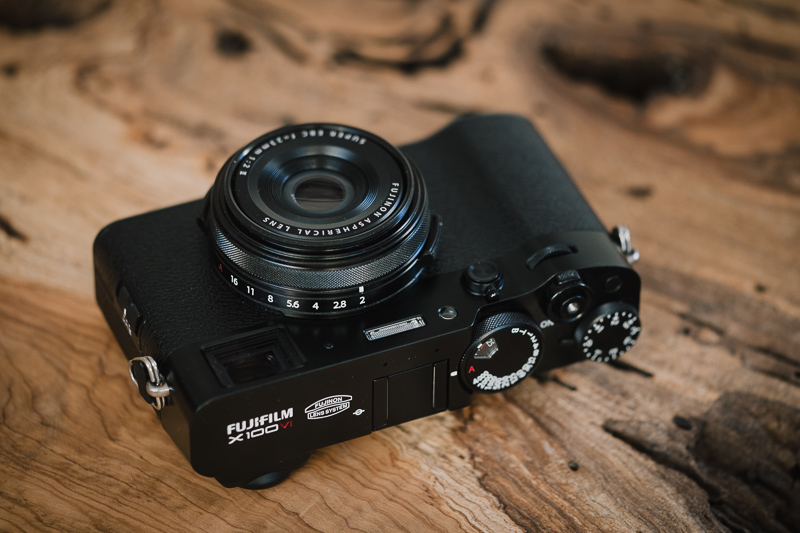
When the first X100 was released in 2010, one of its main selling points was the hybrid viewfinder that let’s you switch between an optical finder with electronic rangefinder overlay and an EVF with a press of a button – by the way something Leica still hasn’t figured out 15 years later and still claims wouldn’t work with their M cameras.
To be perfectly honest, I see little to no reason to use the optical finder here. It doesn’t really tell me more than the EVF and comes with horrible barrel distortion, so I consider this more of an unnecessary gimmick, driving up the production cost. I heard it has some use when using external (non Fuji) flashes though, as it apparently is not affected by the auto exposure preview, so if you are into that, it might still hold some benefit.

Generally from the first generation the Fuji X100 cameras feature thought through “retro” style controls. You have an aperture ring on the lens, a shutter speed dial on top and inside the shutter speed dial an ISO dial. If you wish to adjust the exposure, there is another dial for that to be found on top of the camera.
The aperture ring, ISO dial and shutter speed dial all feature an “A” setting, so by different combinations you get all the PASM modes.
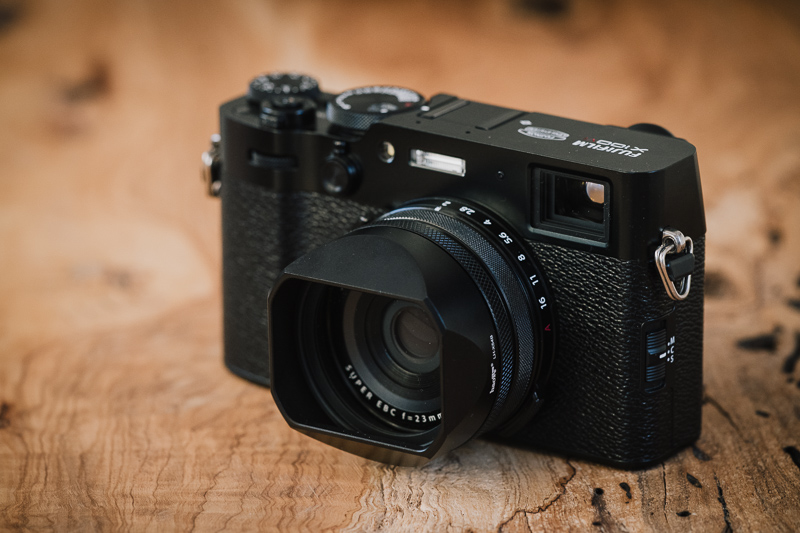
Out of the box this camera only features a reverse (male) 49mm thread. There are several manufacturers that offer filter adapters for this lens. In the picture above you see a Haoge filter adapter that gives this camera a normal (female) 49mm thread and also includes a small lens hood. Admittedly, I wouldn’t be using a lens hood on this camera, as I think its small size is its main appeal.
Autofocus
Autofocus is a category where every new generation of this camera came with alleged improvements. I didn’t do any direct side-by-side tests with comparable lenses on other cameras and I also didn’t use the previous models.
Generally the performance is okay for most use cases and also eye-AF works, but the performance is not on the same level as a Sony A7III (or later) or one of the later Nikon Z cameras.
If you expect great tracking of your child or dog running around, you will probably be disappointed.
Image Quality
Sharpness Infinity
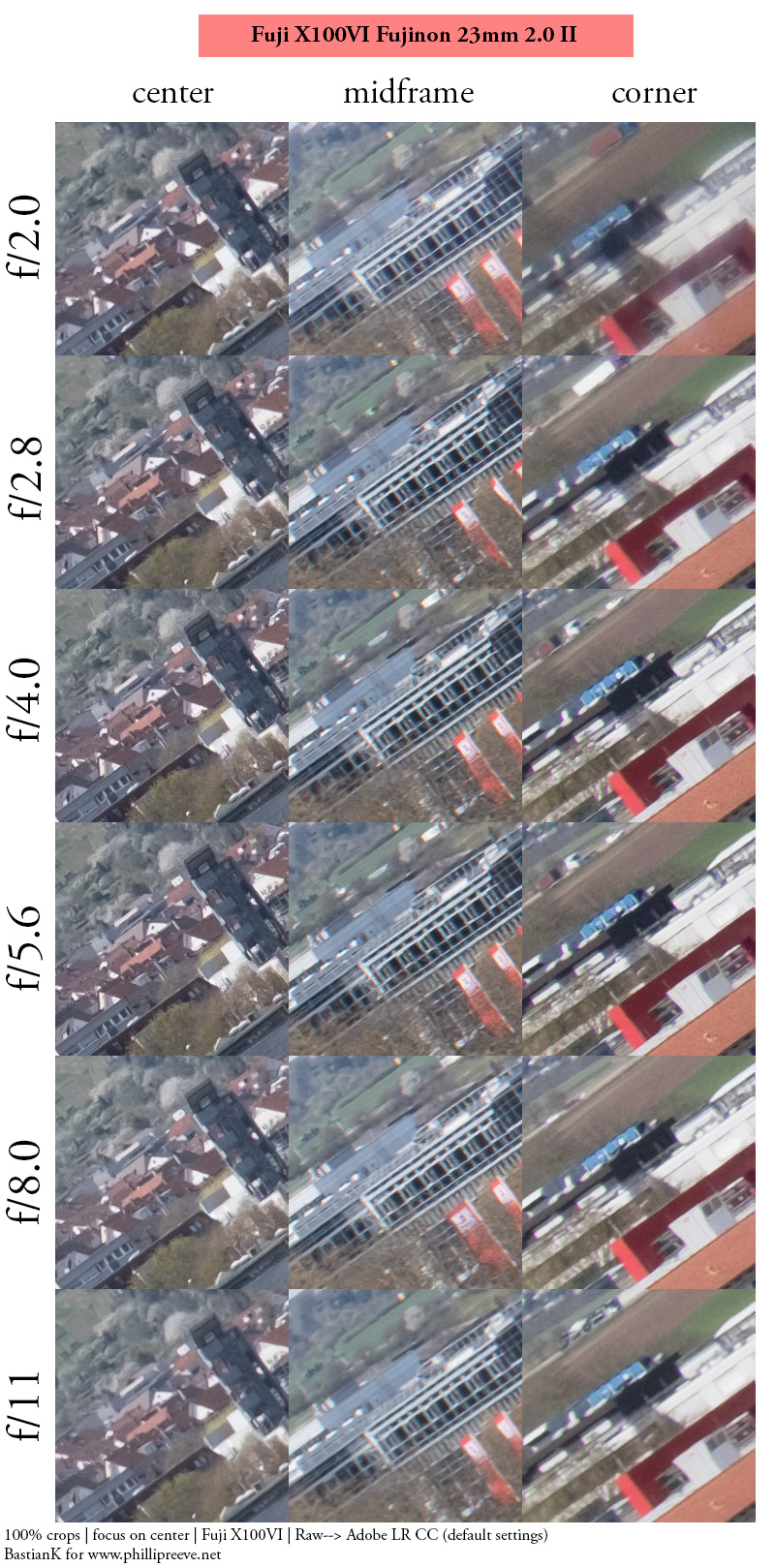
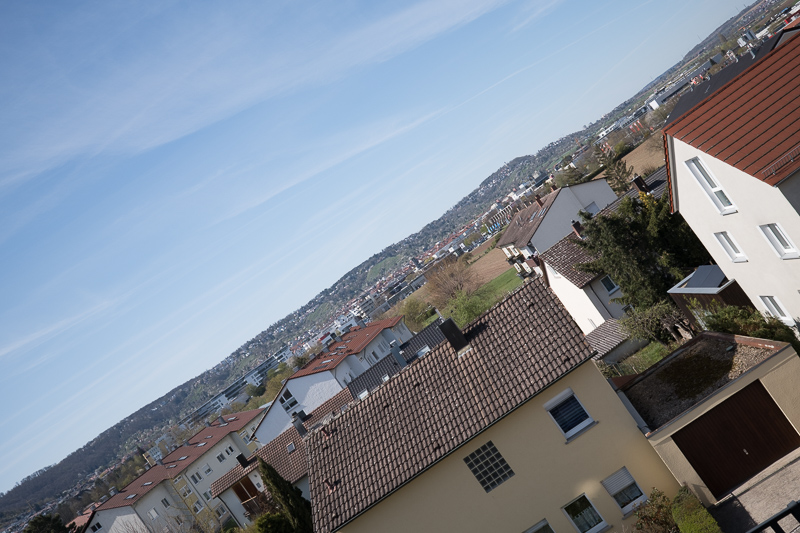
With the fifth generation (X100V) Fuji updated the lens they have used since the original Fuji X100. As they kept its size the same I don’t think there was a lot of room for major improvements, so the only thing that seems to have actually been improved is the performance at closer distances.
Looking at the results from this camera at infinity, I am not sure upgrading its sensor resolution to 40 mp was a great idea though.
Bokeh

The 23mm 2.0 lens (fullframe equivalent of 35mm 3.0) does create a reasonably nice bokeh, but naturally you will only see that when focusing at closer distances.

When taking pictures of smaller children you can still create a shallow depth of field, but if you are after that shallow depth of field wide angle look that can be achieved when taking full body portraits with a fullframe camera and a faster 35mm lens (have a look at my reviews of the Sigma 35mm 1.2 Art DG DN and the Laowa 35mm 0.95 Argus), you will probably end up being disappointed here.

There is one more thing, that a reader pointed out to me. You can change between mechanical and electronic shutter and it seems the mechanical shutter is a bit too slow for some of the faster shutter speeds. If you set the camera to automatic shutter, starting at 1/2000s it will use the electronic one, but between 1/1000s and 1/2000s the mechanical shutter will be used and it still has a detrimental affect on the bokeh rendering, as can be seen from the following comparison:
We had similar experiences with the electronic first curtain shutter on Sony cameras.
If you are shooting a lot under the sun with the lens set to f/2.0, this is something you might want to be aware of.
Jpegs
Now usually I don’t talk about the Jpeg quality as I am always shooting Raw, but the appealing out of camera Jpegs are one of the biggest selling points of this camera, so I thought here it would be worth talking about them.
You can choose from a variety of “film simulations” with names of long discontinued Fuji films. I haven’t shot all of those films, but I have some doubts the files actually look like what you would get shooting those actual films.

The “neutral” profile is Provia and I do find it quite fitting for many scenarios. In combination with the “DR400” dynamic range optimization setting you do indeed get Jpegs with a wide dynamic range and quite appealing colors in many scenarios. For people not that familiar with Raw development, this can indeed be an appealing argument in favour of this camera.
However, the camera also uses rather strong sharpening and noise reduction, the latter significantly reducing the amount of fine details compared to properly developed Raw files.
Fuji also offers an interesting (free) software, the Fuji X Raw Studio. When hooking up your camera to a computer you can edit the Fuji Raw files with those different profiles and camera settings, so you can get Jpegs with all the film simulations later on, e.g. if you were not happy with the results you get in your Raw developer of choice.
Conclusion
The X100 series has a lot of fans and for good reasons. It manages to appeal as “vacation” camera to professional photographers (thanks to its many external controls) and also to amateurs (thanks to its likable out-of-camera results) – a delicate balancing act.
It packs many features – some gimmicky – that many users will never need or use, but they are there and they work. With the many dials it is easy to change the settings if you like to and they also behave as you would expect: you set a certain value on a dial, and this is what you will get. You can also just set all the dials to “A” and won’t have to bother dealing with the settings at all, if you don’t feel like that.
The out of camera Jpegs might indeed be a bit nicer than what you get from other manufacturers – depending on what you are looking for. For me personally the Raw editing is an integral part of my workflow and also with this camera I can get better results (and results that fit my taste better) than what I can get with any of the in camera profiles. But not everyone has the knowledge or the time to deal with the raw development and I can see why this camera may appeal more to those people.
That being said, on closer inspection the image quality is not all that amazing. The lens seems to struggle with the high pixel count and at higher ISO settings strong noise reduction kicks in and the colors also fall apart faster than what I am used to from current fullframe Bayer sensors. For small prints to put in the vacation album this probably won’t matter much though, but I would probably say the same about the latest generation of smartphones.
Being able to fit this Fujifilm X100 cameras in a jacket or even jeans pocket is really its main selling point in my opinion. If this is not that important to you, the price/performance ratio takes a massive hit, as a Sony A7c with a Zeiss 35mm 2.8 or Sony FE 40mm 2.5 G is roughly the same price and also size. Yes, those lenses protrude a bit more, but you also have a more capable and versatile camera in hand.
buy from amazon.com | amazon.de | ebay.com | ebay.de | B&H (affiliate links) for $1599
Sample Pictures

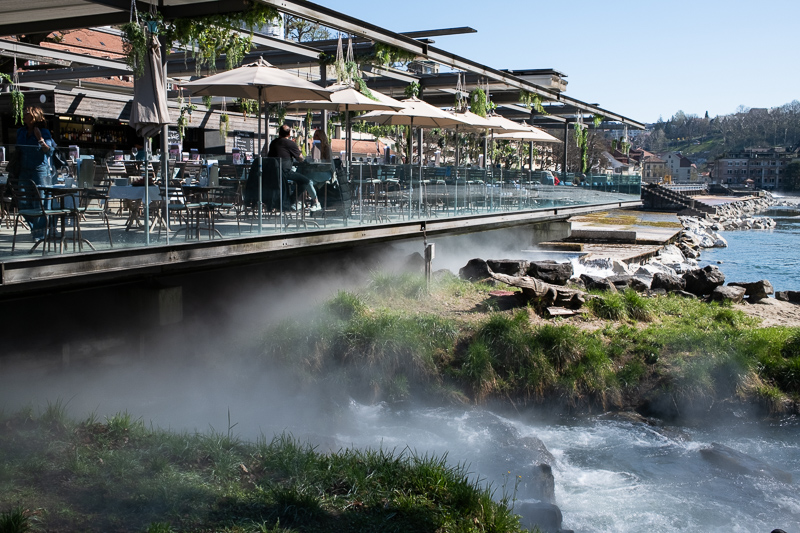


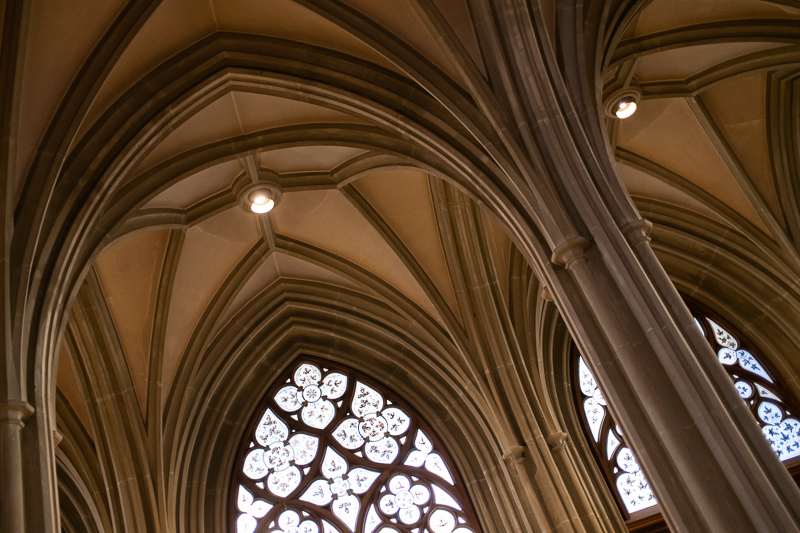
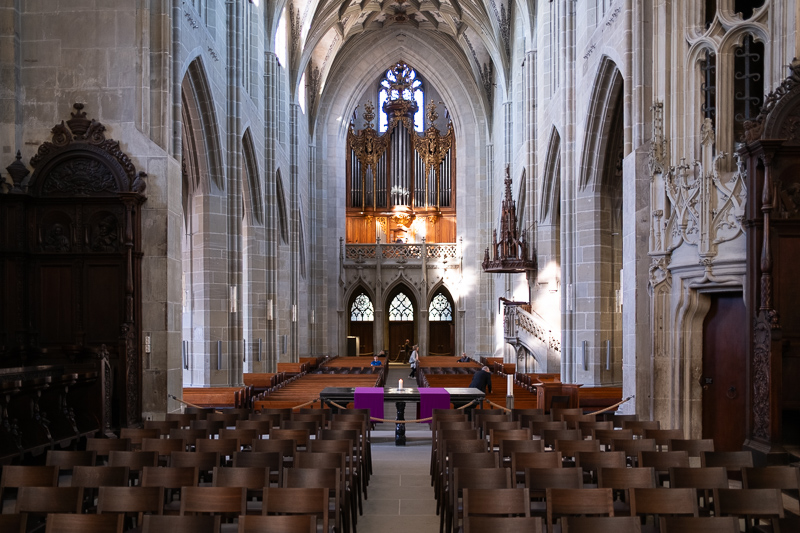


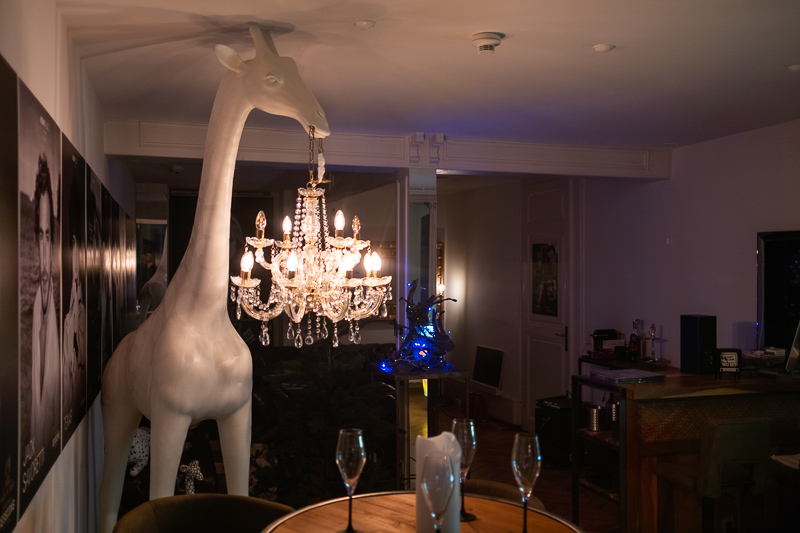

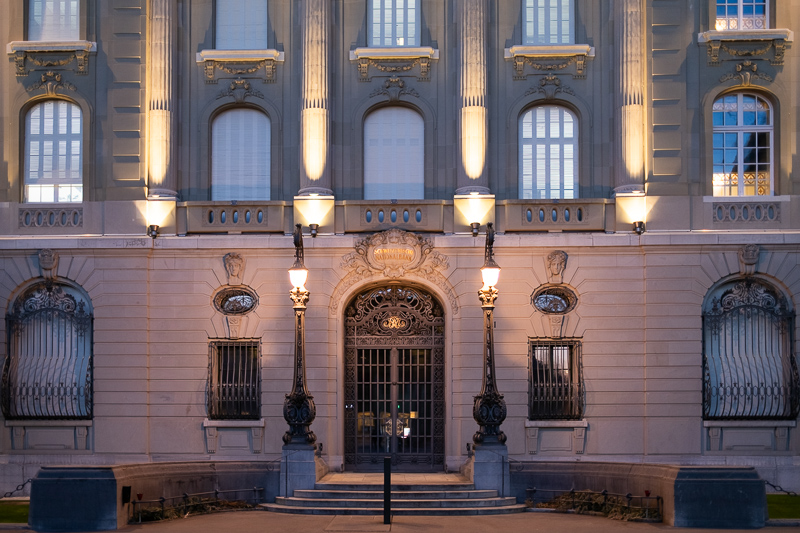
Further Reading
- Review: Sony RX1RII
- Review: Sony FE 35mm 1.4 GM
- Review: Voigtlander 40mm 1.2 Nokton
- Review: Sony FE 40mm 2.5 G
Support Us
Did you find this article useful or just liked reading it? Treat us to a coffee!
![]()
![]()
![]() via Paypal
via Paypal
This site contains affiliate links. If you make a purchase using any of the links marked as affiliate links, I may receive a small commission at no additional cost to you. This helps support the creation of future content.
Latest posts by BastianK (see all)
- 2025 – Year in Review - December 23, 2025
- Review: Sony FE 70-200mm 4.0 G Macro OSS II - December 20, 2025
- Review: Viltrox AF 35mm 1.2 FE LAB - December 17, 2025
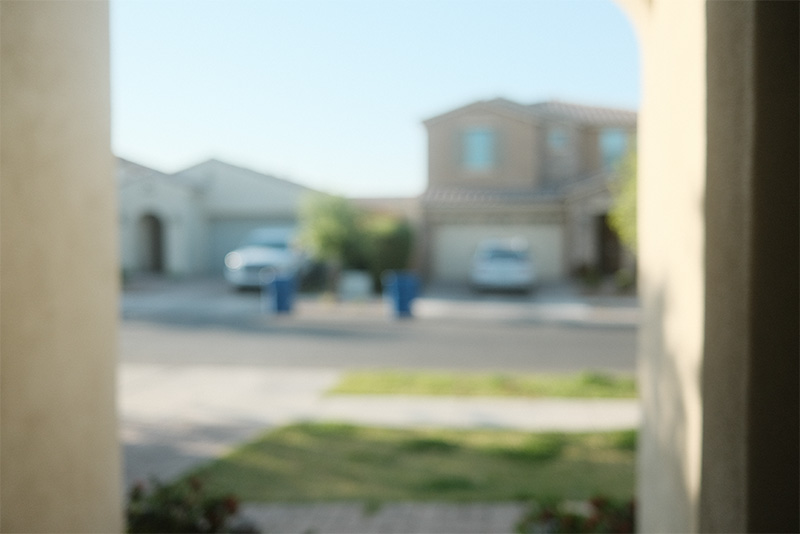
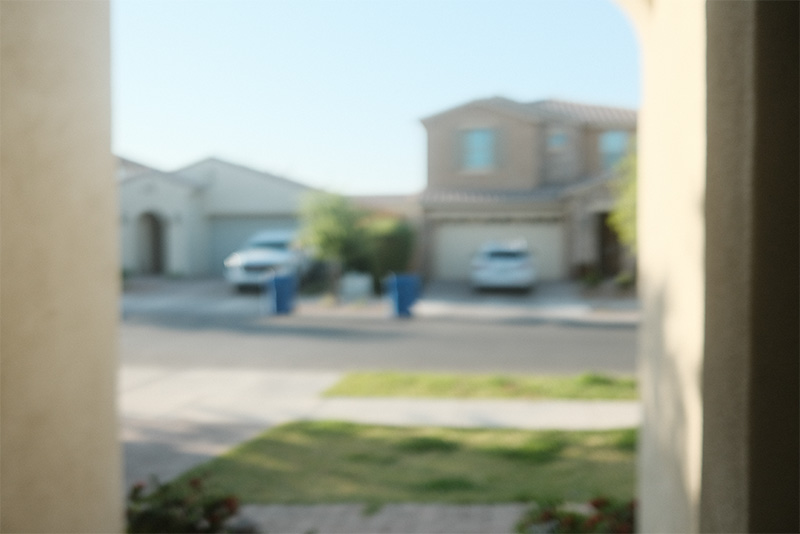












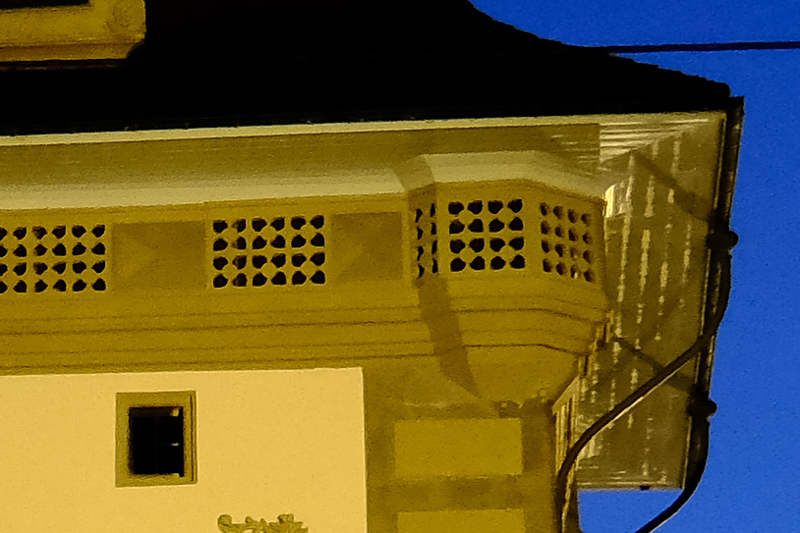
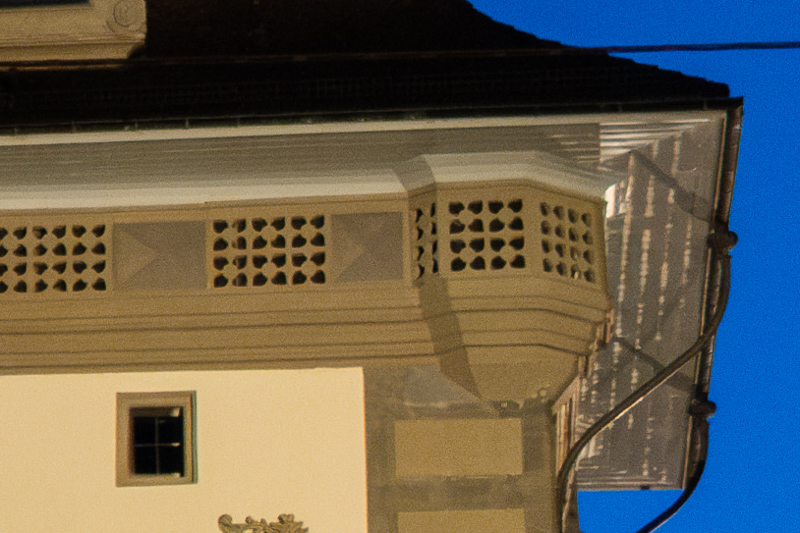
I tried to buy this camera on day 1. It didn’t happen. I was sort of hoping it would become the replacement for the LX100 of days gone by. I have a similarly sized gx9 that I can pop a 17mm lens on and use it as a single lens camera. I’m not sure 35mm is a preferred focal length. I had planned on doing a shoot-out between the Pergear 35/1.4, the Voigtländer 35/1.4 Nokton and the Nikon 35/2 but I realize your reviews would be so much better than what I’d produce. My 35mm project sits partially shot (and partially developed). Thanks for the review of the X100vi, I’m glad I didn’t win the lottery that night.
I really wish the LX100II was a proper upgrade with a tiltable screen and better AF. That camera’s lens is actually really good and versatile.
Sorry, but the LX100II’s lens, while relatively fast, was already overwhelmed by the LX100’s 12MP resolution in the corners. Furthermore, the macro shot was extremely blurry.
DP-Review has plenty of full-resolution examples. Any modern phone in this price range can do a better job with its main lens.
I have used the camera myself and I know what the lens is capable of and what not.
That modern phones do somehat well is because of the computational photography aspects, not because they feature a great lens.
BTW: This concept mimics the human visual system: The human eye has very bad optics, basically only two elements made of glibberish jelly instead of glas, coupled to a big computer (the brain).
During image generation, the brain then adds a lot of believes, prejudices and assumptions to generate what you perceive as a picture.
I’m hoping that the rumors of an LX100iii come true.
Thanks for the review! In fact, I just recently thought that it would be great to see reviews on compact cameras from you.
Good to see that the fact that there is a camera attached to the lens doesn‘t hold you back!
It would be interesting to see a comparison with the Ricoh GR III – I looked at the Fuji, too, but decided for the Ricoh, purely because of size – I wanted a really compact, big cameras I own enough. The handling is different (the Ricoh has no viewfinder), but the concept is similar: APS-C sensor with a wide-angle prime.
There are some reviews that see comparable image quality albeit less pixels, but your reviews are always on a different level…
I agree with the review. I’ve had a X100s which was faulty and I replaced it with an f but although I liked the Fuji controls I found the focus a bit iffy, I also never used the ovf. I think the Panasonic GX80 and GX9 I still have are better cameras when fitted with a small prime, I use the Panasonic 14mm f2.5 a lot, but I do see the appeal of those manual controls on the X100 range.
I had a Ricoh GR II once, only sold it because of dusty sensor, back then a common problem. Always contemplated if I should get an X100 as a portable, yet capable camera when on the run. But never really could justify it, reading mixed reports about the lens. Maybe an a6700 with a small prime lens instead, such as the 20/2.8 or 35/2.8? On the other hand, an a7R is not large to begin with, and paired with a prime, such a camera will always be far superior, as you also point out.
Yeah, sadly all those fixed lens cameras share that dust problem…
Leica q-series beginning with q2 has at least an IP52 dust blocker, that helps, but is not a guarantee no dust will ever get in. I have used this camera for 5 years now and still without any dust problems. Used prices are very good right now, since q3 and q3 43 came out
I like the camera, but man, these latest Chinese ~$150 primes just makes the lens on this one look really bad.
Although bokeh is nice, which is fairly rare for a compact lenses in this FOV, the sharpness is a disaster.
It just never reaches wide open sharpness of some of the latest Viltrox and TTArtisan primes, at any aperture.
I has the X100V and I detested it. Unreliable AF aside, if it’s true that sharpness falls apart a bit (which to me is the last of concerns anyway: who looks images at full magnification anyway?), imagine what a tragedy it has to be having such a disgraceful focus/out of focus fall off, that ugly bokeh, that dull and flat rendition. Eww. Cherry in top: pizza slice bokeh balls from 1/500 upwards, so disappointing.
I agree completely with you.
These fixed cameras made sense in the 1970s, when the shallow mount of a rangefinder helped make them much smaller than an interchangeable lens SLR. Now, with mirrorles having flange depths of 18-25mm I can’t see any advantage for a fixed lens. What exactly prevents them from making exactly the same camera with interchangeable lenses? How much larger would that be, if the lens made for it was more or less the same as this?
A small-ish full frame mirrorless with a Voigtlander Nokton 35 1.5 lens would only be marginally bigger or heavier, with a much faster lens.
I see a point of fixed lens cameras, the lens can dive into the camera body almost touching the sensor surface for size saving with IQ maximising. This 23mm in interchangeable finish stick out lot more from the camera, killing the point of portability. You can say that 20-40mm not matters, I think it matters.
The problem is the sensor price, larger and more expensive a sensor, it’s more waste for only sticking one focal length. And there are primes like 35 f2.8, 24 and 40G, Canon 28 f2 with quite good optical performance, better than this Fuji still not that bigger. Fuji should upgrade this outdated lens and AF, however they still sell X100 series like a hot cake.
The distance between the rear element of the lens and the sensor in this type of cameras is really small. Thus, it is not possible to make exactly the same camera with interchangeable lenses. Same thing in the new Fuji 100RF. Despite some of the comments here, the X100 series has a track record of popularity. Finally, expecting a fixed lens camera to have the same performance of a system camera is not reasonable. As for sharpness, well, someone once said that it was a burgeois concept.
Always nice to have that quote ready, when the need arises to sugarcoat something with subpar performance, isn’t it?
Whilst I do agree that sharpness is relatively (un)important, depending on the practical/artistic needs and creative intention, it’s absolutely important when we compare the performance of different cameras and lenses. I, as a photographer, can decide if I don’t need much sharpness. Someone selling me an ultra-expensive camera shouldn’t have the same luxury.
If a lens is intended to be sharp (that is – it’s not advertised like i.e. a Petzval or a triplet lens for specific artistic purposes), and it’s not sharp relative to other modern optics – that can never, ever be a plus, only a failure.
“It’s not a bug, it’s a feature” is something we often use as a joke, but never expect software developers to say it too. Same goes for this famous (and so much overused, really) quote.
I am not sugarcoating anything. Just drawing attention to the fact that one should not expect a small lens on a fixed lens camera to perform like a more expensive system lens. What is the cost of an equivalent lens is perfectly sharp across its entire field of view from wide open? I have used several generations of the X100 cameras, and never had a photo ruined by its lens. There are compromises in designing small fixed lens cameras.
I’ll end up with GFX100RF because I want top level IQ. This camera is more like a fun tool, main advantage is the shooting experience and second is the absolute IQ.
Still waiting for Sony making a high-end rangefinder style camera like GFX100RF body, with large EVF and tilting screen. But it’s seems to me unlikely, articulating screen (which I don’t like) is the new standard, A7RV’s multi angle screen is too thick for a compact rangefinder, also Sony like to miniaturising like C series, I prefer my A7RV with small lenses over the crippled C series.
I use an RX100 VII. If I’m going to compromise on light gathering, it means I’m probably shooting daytime, travelling or have a small table top tripood. It has a sharp (for it’s size very sharp) 24-200 equivalent lens with image stabilization and very fast autofocus.
I hope they do a remake with a faster 24-105 style lens, slightly bigger maybe and also a modernized sensor. The market for such cameras is quite small. Stuck between travel photography which smartphones handle better at night and budget Vlogging cameras.
If not compromising, then it’s a FF Sony with a lens or two all the way.
There’s still a market for which that combination of 1″ sensor plus fast-ish 24-200 is absolutely perfect: concerts. A lot of venues ban ILCs outright and while smartphone teles have gotten better they still get embarrassed by that combination of sensor+lens on the late RX100 models (particularly when one needs 1/500 + high ISO + bursts but computational tricks fall apart due to subject motion).
I own a couple small M4/3 bodies plus the venerable Oly 75/1.8 (a 150mm equivalent combination that’s easier to pass off as a P&S with a pancake mounted) and even a couple small FF tele primes like the SY & TTArtisan 75mm; the former don’t track/C-AF as well as my Sony gear and the latter often gets flagged by security as “professional gear” even when the rules say they do allow lenses up to 6″ or whatever…
That’s lead me to rent the RX100 VII about 3x in less than 2 years, I really wish they’d release an updated model with UHS-II and USB-C charging. It would pain me to pay even used prices for the Mk VII with those limitations in place, the slow clearing buffer has bit me a few times when I was shooting stills and wanted to switch over to video (but it was still writing to card).
Ope that was meant as a reply to the last comment…
The X100 used to make a little more sense when we didn’t have as many great but tiny FF primes, yeah they’re not quite as pancake-like as the X100’s lens but for most people it’s close enough. I live in the tropics (for now) so no jacket pockets, I’d need a bag either way to carry the X100 or an ILC with 2 small primes, and in most instances I’d rather have the latter.
I wouldn’t carry an expensive camera in my pocket anyway, it would just feel wrong. It may mimic a point and shoot of the olden days, but it’s not. It’s not as compact, not as solid, and it’s much more expensive.
But I guess that’s why they cost as much as they do, so you can empty your pockets and leave space for a camera. 🙂
And I don’t talk about retail price, which is irrelevant, since Fuji doesn’t even want to sell you a camera.
Thank you for performing the valuable service of trying to discourage demand for this camera! I doubt if it will have much effect, since the people who typically do buy and like the X100 cameras are NOT the same people as those who typically run home to open their files in Photoshop and examine the corners at 100%, or who pore over bokeh comparison tests, or can convince themselves that a 36×24 mirrorless camera plus 35mm FL lens is “roughly” the same size.
Still, this review may have dissuaded at least a few prospective buyers of the X100VI… meaning that people who DO appreciate the feature package and “get” the hybrid viewfinder concept (such as myself) stand at least a slightly improved chance of being able to obtain one. So again, thank you!
The worst camera is always the one that you don’t have with you. If it’s sitting in the drawer, the best lens and sensor don’t help.
So the real question is: Will I take such a camera to places where I don’t carry my ILC (Interchangeble Lens Cam)?
If the answer is no, no more thinking is needed. Buy an ILC. It’s more value for money.
For me, the difference is my jeans pocket – if a camera doesn‘t fit there, it needs a belt or bag, like an ILC, so I can as well take my ILC.
And that is, for me, the weakness of the Fuji: Too big for the pocket.
I find it hard to justify buying a fixed lens camera. My smartphone has a 8.9mm f/1.63 lens, which has an equivalent FoV and DoF of a 23mm f/4.2 full frame lens. Sure the Fuji x100VI collects roughly 1 stop more light, but I can’t leave a comment on philipreeve.net with the x100VI.
I also enjoy editing the RAW files on my phone directly using Lightroom and Photoshop, and then sharing it immediately. The photos can be backed-up to the cloud in the background too.
strange,
no one recommend the X-E4 plus lets say the 27mm 2.8.
the .8 difference is hardly visible.
Looks like a fun toy to buy if just landed a tech job and have money burning a hole in your pocket. I would prob just settle for one of the older cheaper Sony RX100s. Do you anticipate reviewing the (or a) RX100 anytime?
Had RX100 MKI for some time. Not planned at the moment to have a closer look at any of them.
What did you think of the RX100? Given that you don’t have it now I imagine it was nothing to write home about?
It was okay for its time, today I would rather use one of the fancier smartphones.
I find Ricohs GRii+iii+iv form factor much more appealing as a secondary camera beside FF, because its actually pocketable, Not like the X100 which is only smaller considering bigger/faster FF lenses.
Also Ricohs GR 28mm lens is incredibly sharp.
It would be nice to see a review of the GRIII from Bastian, too.
From the photos, my impression is that the lens is comparable to the Fuji (being a bit slower), and the less megapixels don’t matter because of the limitations of the lens.
But of course, only a qualified test can clarify this.
Yeah, if I get the chance I will also have a look at the Ricoh.
Would be great 🙂 And if you have a chance, don’t refuse also GRII. I see that you did not pay too much attention to the central shutter/nd aspect of x100, so maybe GRII could be the 2nd chance (GRIII has no flash) here 🙂 For me the insane effective power of the built-in flash when in bright sun (mostly look, but also utility for fill-in) was one of the main appealing points for both cameras, and that’s also the reason why I never got GRIII 🙂 I would encourage also to play with the x100 in this context as well if you did not ship it back yet 🙂
I really do not understand all these negative comments on the X100VI.Whan you use it, you realise that you have a very high quality and attractive package, even if it is less flexible than a ILC
First the lens : the pictures shown in the review clearly demonstrate that the lens is far from bad. Starting at 2.8 it is a very good lens, not the absolute best, but more than enough of 99% of the needs, and it can do macro
Second the package : the X100VI packs a lot of features in a very light and small form factor :
> a lens that is (at least) good
> the lens can do macro
> you have a fill flash (also useful for macro)
> a ND filter
> the existence of 2 focal length converters (one for 28mm equiv, very small and useful, one for 50mm equiv, bigger, but less frequently useful)
> the optical viewfinder as an option (useful for seeing what is currently outside of the field of view)
The complete package :
> X100Vi + filter to have weather resistance when needed + small charger and cable + 28mm FL converter
is less than 800 grams measured on the scale and goes into either a very small bekt bag or 2 jacket pockets.
And there are 2 bonuses to having a fixed lens :
> you have a specifically tailored micro lens array (improves IQ)
> when you install the converters (less flexible than a ILC obviously) you do not expose the sensor to ambient dust
Hope this helps
Saying that lens can do macro with a maximum magnification of 1:5 is a bit of a stretch.
It focuses somewhat close, but this is not something special that pretty much any other device (or compact prime) wouldn’t be able to do, too.
While not a true macro, it focuses down to 10cm, which reproduces a larger image size for any given object at that distance than the Leica Q3 – which can only focus as close as 17cm (on a 28mm lens), or the Sony RX1rIII, which can focus to 14cm, both of which claim to have ‘macro’ modes.
Sony RX1 series offers a maximum magnification of 1:3.8, so: wrong.
Wrong in what way? I just gave close focusing limits and pointed out that it would produce a larger image size for any given object at that distance than the Q3, and slightly more than the RXIrIII.
Fuji does not give a close focus magnification or magnification ratio for the X100VI as far as I can see only the close focus distance of 10cm.
If the 10cm distance is measured from the front of the lens (as some manufacturers specify for macro), the ratio would be 1:33.
Calculation:
Focal length: 23mm
Focus distance: 100mm
M=23/(100-23) = 23/77 = 0.2987
Expressed as a ratio:
0.2987 = 0.3, roughly.
Ratio = 1: (1/0.3) = 1:33
So the subject appears on the sensor about 0.3 of its actual size, whereas the Sony appears at 0.26 (official) of its actual size.
In the way that I expressed it originally: it “reproduces a larger image size for any given object at that distance than the Sony RXr1III” can was perfectly correct. This is, in the end, all that matters. I have tried them side by side, and the Fuji yields a slightly larger screen filling image than the Sony. Just compare them.
I quite agree with you, a very nice package of qualities. The lens has been tested by dozens of other very meticulous reviewers and most have found it pretty good – not perfect – and backed up their comments with comprehensive comparisons, certainly producing images with far more detail than any 35mm film camera could using any film other than perhaps very slow, highly technical and not very practical films.